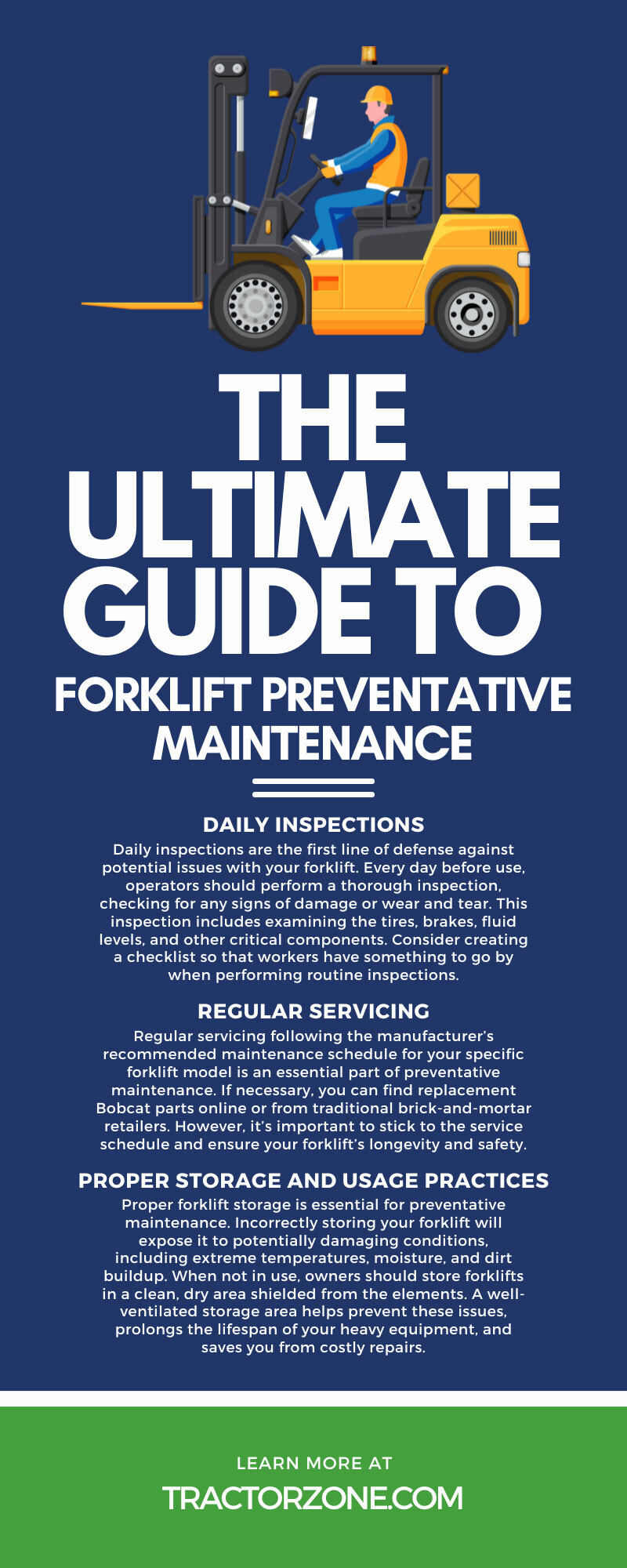The Ultimate Guide to Forklift Preventative Maintenance
Feb 7th 2024
For those operating in the heavy equipment industry, underestimating the importance of properly maintaining equipment can be a costly mistake. Regular maintenance extends the lifespan of heavy machinery and ensures safe and efficient operation.
In this ultimate guide, we’ll cover everything you need to know about forklift preventative maintenance, from its benefits to the steps involved. Let’s dive in and learn how to keep your forklifts running smoothly.
Forklift preventative maintenance is a proactive approach to maintaining your equipment. It involves regularly scheduled inspections, servicing, and repairs that help prevent breakdowns and keep your forklift in top working condition. It’s a crucial aspect of fleet management, especially in the construction industry, where forklifts are an essential tool. Neglecting preventative maintenance can result in costly downtime, repairs, and even accidents.
Preventative maintenance of your forklifts carries many benefits that directly impact your bottom line. By learning about your equipment and how to care for it, you can ensure you get the job done quickly and efficiently. Explore a few reasons preventative maintenance is so important below.
Understanding the basics of preventative maintenance can make a huge difference to on-site workers.
The process of forklift preventative maintenance typically includes several key steps, each playing a vital role in keeping your equipment in optimal condition.
Daily inspections are the first line of defense against potential issues with your forklift. Every day before use, operators should perform a thorough inspection, checking for any signs of damage or wear and tear. This inspection includes examining the tires, brakes, fluid levels, and other critical components. Consider creating a checklist so that workers have something to go by when performing routine inspections.
Regular servicing following the manufacturer’s recommended maintenance schedule for your specific forklift model is an essential part of preventative maintenance. If necessary, you can find replacement Bobcat parts online or from traditional brick-and-mortar retailers. However, it’s important to stick to the service schedule and ensure your forklift’s longevity and safety.
Proper forklift storage is essential for preventative maintenance. Incorrectly storing your forklift will expose it to potentially damaging conditions, including extreme temperatures, moisture, and dirt buildup. When not in use, owners should store forklifts in a clean, dry area shielded from the elements. A well-ventilated storage area helps prevent these issues, prolongs the lifespan of your heavy equipment, and saves you from costly repairs.
Each forklift will have its own maintenance needs, depending on its make, model, and usage. Below are a few examples of preventative maintenance tasks that you should consider.
Filters, including air and fuel filters, play a pivotal role in the operation of your forklift. They filter out dust, debris, and other contaminants that can damage the engine over time. Regularly replacing these filters can prevent premature wear and tear and maintain the optimal performance of the forklift.
Fluids such as engine oil, transmission fluid, and hydraulic fluid are the lifeblood of your forklift. Regularly checking and replenishing these fluids is crucial for the smooth operation of your heavy equipment. Low fluid levels can cause overheating and seriously damage the engine and other components.
The condition of the forklift’s tires directly affects its safety and performance. Worn-out or improperly inflated tires can lead to instability and accidents. Regularly inspecting the tires for signs of damage and maintaining the correct tire pressure is another essential step in preventative maintenance.
The braking system is one of a forklift’s most critical safety features. Regular inspection and maintenance of the brakes can prevent accidents and ensure the operator’s and other workers’ safety on the construction site.
These are just a few examples. A comprehensive maintenance program should include a wide range of tasks tailored to the specific requirements of your forklift and operating conditions. Always refer to the manufacturer’s guidelines for proper maintenance practices. If you’re unsure about any aspect of forklift maintenance, don’t hesitate to seek professional advice.
Remember, safety is an integral part of forklift preventative maintenance. By adhering to safety guidelines and measures, companies can significantly decrease the risk of accidents and injuries on the construction site. Crews can adopt several strategies to ensure safety during forklift maintenance.
Workers should always wear appropriate personal protective equipment (PPE), such as gloves, safety glasses, and steel-toed boots, during maintenance tasks. The use of PPE can protect maintenance personnel from potential hazards associated with handling heavy equipment.
Following the manufacturer’s guidelines for maintenance is crucial to ensuring safety. These guidelines provide the correct procedures for servicing and repairing the forklift, thus reducing the risk of accidents caused by incorrect maintenance practices.
Maintain a safe and clean work environment during the maintenance process. Keep the maintenance area free from clutter and immediately clean all spills to prevent slips and falls.
Invest in professional training for your maintenance personnel. Professional training equips them with the skills and knowledge to handle maintenance tasks safely and effectively.
By incorporating these safety measures into your forklift preventative maintenance program, you can ensure your employees’ well-being while increasing the efficiency and longevity of your heavy equipment. Remember, a safe work environment is a productive work environment.
Proactive and regular forklift preventative maintenance ensures the longevity of your heavy equipment, reduces the frequency and cost of repairs, enhances operational efficiency, and fosters a safer work environment. From daily inspections and regular servicing to proper storage and comprehensive training, each component of a well-rounded maintenance program plays an integral role in optimizing the performance of your fleet.
